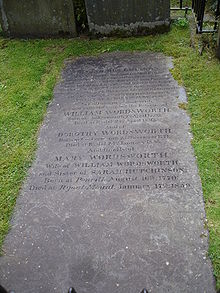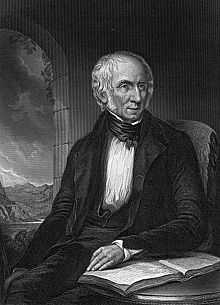William Wordsworth
William Wordsworth (* 7. April 1770 in Cockermouth , UK ; † 23. April 1850 in Rydal Mount , Great Britain ) was a British poet and a leading member of the English Romantic movement , which he 1798 by along with Samuel Taylor Coleridge wrote Lyrical Ballads ( Lyrical Poems ) initiated. When his best known works of his early autobiographical poem are The Prelude ( Prelude ) from 1798 and the Daffodil poem I Wandered Lonely as a Cloud of 1804th
Life
He was born the second of five children of a lawyer at Wordsworth House in the Lake District. His sister Dorothy Wordsworth , with whom he was closely connected and later lived together - even after his marriage - and with whom he went on several trips, later also published poems. His older brother Richard was a lawyer, his brother John a captain (he died in the shipwreck of his ship in 1805) and his brother Christopher clergyman and later a master's degree from Trinity College, Cambridge. After his mother's death in 1778 (his father died five years later), Wordsworth was sent to Hawkshead Grammar School and he then studied at Cambridge University (St. John's College) from 1787 to 1791 .
In his student days, Wordsworth was enthusiastic about the French Revolution and for this reason traveled to revolutionary France in 1790. In order to deepen his impressions, he made another trip through France, the Alps and Italy the following year. With the establishment of the reign of terror in France, however, Wordsworth's disappointment grew and he increasingly distanced himself from the aims of the revolution. His departure turned into opposition in 1798 when French troops conquered Wordsworth's valued Switzerland - from then on Wordsworth admitted to conservatism .
In Orléans in 1792 he also met Marie-Anne (Annette) Vallon, with whom he had a daughter Caroline, born in December 1792. Like her family, she was a royalist. Financial and other reasons prevented the marriage, at the end of 1792 he traveled to England again and due to the political events (declaration of war in February 1793) he was only able to travel to France much later. Both remained in correspondence, and Wordsworth met Anne Vallon and his daughter in Calais in 1802, two months before his marriage to Mary Hutchinson. Because of the new outbreak of war, they did not have contact again until 1814 (by letter via Wordsworth's sister Dorothy). In 1816 his daughter married under the name Wordsworth with the consent of her father.
In 1793 Wordsworth published his first poems with the collections An Evening Walk and Descriptive Sketches . In 1795 he became close friends with Samuel Taylor Coleridge; two years later he settled in its neighborhood. Together they published the Lyrical Ballads , which were important for English Romanticism in 1798 ; they contained some of the most famous works by the two poets, e.g. B. Wordsworth's Tintern Abbey and Coleridges Ancient Mariner . In the same year they went on a trip to Germany with Wordsworth's sister Dorothy. In Goslar , Wordsworth began work on his autobiographical poem, which later became known as The Prelude .
Back in England, he moved with his sister to Grasmere in his native Lake District , which is why he is counted among the so-called Lake Poets , together with Robert Southey and Coleridge, who temporarily lived in nearby Keswick (Cumbria) . In Grasmere, Wordsworth married his childhood friend Mary Hutchinson in 1802. With her he had five children, two of whom died in 1812. The marriage was made possible by £ 4,000 paid off by William Lowther, Earl of Lonsdale, as outstanding debt on Wordsworth's father.

For years, Wordsworth was planning a long philosophical poem in three parts to write, he The Recluse ( The Hermit ) wanted to call. In 1798/99 he had started with an autobiographical poem, which he never named, but referred to as a poem for Coleridge , and which was to form an appendix to the Hermit (later known as The Prelude ). In 1804 he began expanding it and making it a prologue rather than an appendix. He had completed the poem by 1805, but he did not want to publish such a personal poem until the entire hermit was complete. Leonardo da Vinci had already described the power of loneliness in similar words before him.
In 1813 Wordsworth moved to Rydal Mount , Ambleside , where he lived the rest of his life. The following year he released The Excursion as the second part of the three-part Hermit . However, he had not completed the first and third parts, which he would not succeed until the end of his life. Modern critics have noted a decline in Wordsworth's creativity from 1815 onwards. Around 1820, however, his reputation rose because contemporary critics assessed his early poems more positively.
Wordsworth remained a staunch supporter of the Church of England throughout his life . In 1843 Wordsworth was awarded the honorary title of Poet Laureate . On April 23, 1850, the poet died of pleurisy in Rydal Mount and was buried in the cemetery of St. Oswald's Church in Grasmere.
A few months after his death published Wordsworth's widow Mary his long autobiographical poem for Coleridge as The Prelude ( Prelude ). The work attracted little interest at the time, but is now regarded as Wordsworth's masterpiece.
In 1845 he was elected an Honorary Fellow of the Royal Society of Edinburgh .
reception
TC Boyle prefixed his novel The Light (2019) with a quote from William Wordsworth as the motto.
Orhan Pamuk chose a line from a poem by William Wordsworth for his novel This Strangeness in Me (2014).
Works (selection)

-
Lyric ballads, with some other poems (1798)
- "Simon Lee"
- "We Are Seven"
- "Lines Written in Early Spring"
- "Expostulation and Reply"
- "The Tables Turned"
- "The Thorn"
- "Lines Composed A Few Miles above Tintern Abbey"
-
Lyric ballads, with some other poems (1800)
- Preface to the Lyrical Ballads
- "Strange fits of passion have I known"
- "She Dwelt among the Untrodden Ways"
- "Three years she grew"
- "A Slumber Did my Spirit Seal"
- "I traveled among unknown men"
- "Lucy Gray"
- "The Two April Mornings"
- "Nutting"
- "The Ruined Cottage"
- "Michael"
-
Poems in two volumes (1807)
- "Resolution and Independence"
- " I Wandered Lonely as a Cloud "
- "My Heart Leaps Up"
- "Ode: Intimations of Immortality"
- "Ode to Duty"
- "The Solitary Reaper"
- "Elegiac Stanzas"
- "Composed upon Westminster Bridge, September 3, 1802"
- "London, 1802"
- "The world is too much with us"
-
The Excursion (1814)
- "Prospectus to The Recluse "
-
Ecclesiastical Sketches (1822)
- "Mutability"
-
The Prelude (1850, posthumous)
- The prelude; or, Growth of a Poet's Mind
literature
Bibliographies
- NS Bauer, William Wordsworth. A Reference Guide to British Criticism, 1793-1899 (Boston, 1978).
- DH Stam, Wordsworthian Criticism, 1964-1973. An Annotated Bibliography, Including Additions to Wordsworthian Criticism, 1945-1964 (New York, 1974).
Work editions
- The Poetical Works Eds E. de Selincourt and H. Darbishire. 5 vols ( Oxford University Press , 1940-1949).
- The Prose Works of William Wordsworth Eds WJB Owen and JW Smyser. 3 vols (Oxford University Press, 1974).
Biographies
- William Wordsworth, Court Poet of England . In: Illustrirte Zeitung . No. 8 . J. J. Weber, Leipzig August 19, 1843, p. 123-124 ( books.google.de ).
- Stephen Gill (Ed.): The Cambridge companion to Wordsworth . Cambridge University Press 2003. ISBN 0-521-64116-0 .
- Stephen Gill: William Wordsworth. A life . Clarendon Press, Oxford 1989. ISBN 0-19-812828-2 .
- John L. Mahoney: William Wordsworth, a poetic life . Fordham University Press , New York 1996. ISBN 0-8232-1715-9 .
- John Williams: William Wordsworth, a literary life . Macmillan, Basingstoke 1996. ISBN 0-333-57418-4 .
- John Worthen: The life of William Wordsworth: a critical biography , Chichester [u. a.]: Wiley-Blackwell, 2014, ISBN 978-0-470-65544-3
- Jonathan Bate: Radical Wordsworth: the poet who changed the world , London: William Collins, 2020, ISBN 978-0-00-816742-4
further reading
- JF Danby, The Simple Wordsworth. Studies in the Poems 1797-1807 (London, 1960; repr. 1968).
- Geoffrey Hartman , Wordsworth's Poetry 1787-1814 ( Yale University Press , 1964; rev. 1971).
- Geoffrey Hartman, Wordsworth, Inscriptions, and Romantic Nature Poetry. Essays in Honor of Frederic Pottle. New Haven 1965.
- Herbert Lindenberger: William Wordsworth's "The Prelude" and the consciousness of time . In: Willi Erzgräber (ed.): Interpretations Volume 8 · English literature from William Blake to Thomas Hardy . Fischer Verlag, Frankfurt a. M. et al. 1970, pp. 67-90.
- M. Jacobus, Tradition and Experiment in Wordsworth's Lyrical Ballads (1798) (Oxford University Press, 1976).
- David Haney: William Wordsworth and the Hermeneutics of Incarnation. Pennsylvania State University Press, University Park 1993, ISBN 978-0-271-02641-1 .
- FB Pinion, A Wordsworth Chronology (1988).
- Hugh Sykes Davies : Wordsworth and the Worth of Words . Cambridge University Press, first edition 1986, 4th edition 2010, ISBN 978-0-521-12914-5 (online)
Fiction
- Val McDermid, Das Moor des Vergessens (2006) Knaur Taschenbuch Verlag (novel)
Web links
- Literature by and about William Wordsworth in the catalog of the German National Library
- Works by and about William Wordsworth in the German Digital Library
- To Toussaint Louverture - poem by William Wordsworth
- Wordsworth: Foreword to "Lyrical Ballads" , 1802; in the project "Poetry Theory"
- "Daffodils" (daffodils) in German translation by Bertram Kottmann
- Selection from his work - English and German - translated into German by Dietrich H. Fischer
- Biography, Victorian Web
Individual evidence
- ↑ Émile Legouis William Wordsworth and Annette Vallon , London, Dent 1922. George Harper Wordsworth's french daughter , Princeton 1921
- ^ Fellows Directory. Biographical Index: Former RSE Fellows 1783–2002. (PDF file) Royal Society of Edinburgh, accessed April 26, 2020 .
| personal data | |
|---|---|
| SURNAME | Wordsworth, William |
| BRIEF DESCRIPTION | British poet |
| DATE OF BIRTH | April 7, 1770 |
| PLACE OF BIRTH | Cockermouth , UK |
| DATE OF DEATH | April 23, 1850 |
| Place of death | Rydal Mount , UK |

